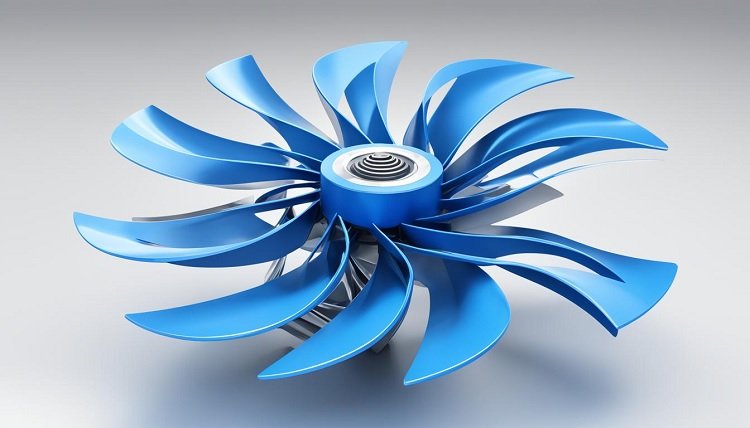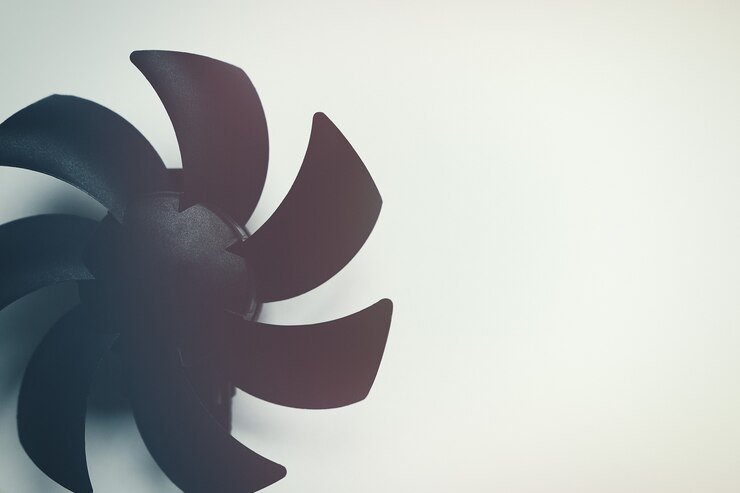In the world of industrial fans and blowers, aiming for high efficiency is key. Ever wondered about the best fan blade design and its effect on performance and energy use? It all comes down to the shape, pitch, and curvature of the blades. These details are crucial for a fan’s success.
The secret to high efficiency is in the impeller, the part that spins and makes the air move. Its design is vital for a fan to run well. Details like the shape and number of blades, their angle, the size of the impeller, and the space around its edges, are all very important.
So, what makes some fan blades more efficient than others? And how much can these advanced designs help in the real world? We’ll explore the fascinating field of fan blade design. We’ll learn what it takes to reach top efficiency.
Key Takeaways
- Optimised impellers can achieve efficiencies of up to 90%, far exceeding conventional impellers
- Backward-curved blades are a hallmark of efficient fans, reducing turbulence and improving airflow
- Efficient impellers can lead to significant energy savings, enhanced performance, and longer fan lifespan
- Impeller design is a critical factor in fan efficiency, with optimised designs outperforming conventional ones
- Proper fan clearance, size selection, and regular maintenance are also key to enhancing fan efficiency
Understanding the Importance of Impeller Design
The core of a fan or blower is the impeller, which spins to create airflow and pressure. The way the impeller is designed greatly affects how well the fan works. Features like the shape of the blades, the distance between them, their angle, and the space around them all play a big role. They impact how much air and pressure the fan can produce, as well as how much power it uses.
What is an Impeller?
An impeller is the part that rotates in a fan or blower, pushing air or gas. Its design is key in making the fan efficient and effective. Manufacturers work hard to design impellers for top performance. This boosts a fan’s ability to save energy, move air better, and be quieter.
Key Factors Influencing Fan Efficiency
The impeller is crucial for a fan’s power, and its design really matters. Things like blade shape, blade number, blade angle, blade curvature, impeller diameter, impeller width, and impeller clearance are all important. They help the fan move air well and with low energy use. Smart design choices can make fans much more efficient.

Advantages of an Optimized Impeller Design
An optimally designed impeller greatly boosts fan efficiency and performance. It cuts down on energy use. This means lower costs to operate over the fan’s life. It’s especially crucial today with high energy costs and a need for more efficient tech.
Another benefit is improved fan performance. A well-designed impeller helps the fan move more air at the same speed. This improves how the system works. It’s vital for places that must keep air flow steady, like in industries or shops.
Lower Noise Levels
An efficient impeller also makes the fan quieter. It reduces the noise because of less turbulence and better airflow. This is a huge plus in places where loud fan sounds are a problem, like offices or homes.
Extended Fan Lifespan
Impellers with optimal designs don’t wear out easily. This can make the fan last longer. It means less maintenance and more savings over time. By focusing on fan efficiency and impeller design, your industrial fans can perform well for many years.

Research and Studies on Impeller Design Optimization
The University of California, Berkeley, has found that impeller design really matters. They compared how well fans work with different impeller designs. What they found was amazing. Fans with the best impellers could work up to 90% better than the usual ones. This is a big deal because normal impellers only reach about 60% efficiency. The graph shows clearly how much better these smart impeller designs are.
They looked into a fan’s blade shape and found something cool. By making the fan blades tapered, the fan could push air better, up to 8.8% more. Changing the fan blade a little made a big difference. The fan did its job 3.1% better and could move more air. Also, changing the fan’s exit channel slightly reduced noise by lowering pressure pulsation.
Scientists have also used special methods to make fans work even better. They looked into using genetic algorithms and something called the disturbance CST function. These methods helped them make better fan parts from different materials. For example, they improved steel beams for use in high heat and looked into making strong structures under heavy loads.
They’ve also been working on ways to improve all kinds of structures. One method they used is an enhanced type of particle swarm optimisation. It’s good for solving tricky problems. They also came up with better criteria for designing beams. These new approaches in impeller design optimisation show how hard experts are working to make fans more efficient. Their research and studies are key to reaching new levels of fan efficiency.

Most Efficient Fan Blade Design
Many fan blade designs help make fans more efficient. Some popular types are:
Backward-Curved Blades
Backward-curved blades are often seen in efficient fans. They make the air move backwards, which reduces mess and makes the fan work better. These fans are powerful yet quiet, making them a top pick.
Airfoil Blades
Airfoil blades look like wings on a plane. They cut down on air resistance and make airflow better. This makes the fan not only efficient but also good at saving energy. They’re often used in big, powerful fans for places like factories.
Radial Blades
Radial blades stick out from a central point. They help move more air through tight spaces and change pressure into speed well. These blades fit best where lots of air is needed, like in big fans for getting rid of dust.
Impeller Design for Dust Collection Applications
The efficiency of dust collector fans is key. A well-designed impeller can grab and move tiny dust bits. This makes workplaces cleaner and safer.
Different fan blades help the fan work better. These include backward-curved, airfoil, radial, and backward-inclined blades. They lower energy use, make fans work better, and last longer.
Choose fans with good impeller designs. Look for ones approved by the Air Movement and Control Association (AMCA). Also, make sure the fan fits well and is kept up. This all helps the fan work at its best.
Choosing the Right Fan with an Efficient Impeller
Choosing an industrial fan is important. Focus on ones with well-designed impellers. They give great airflow and are energy efficient. Look for fans with AMCA certification for top efficiency and performance.
Certifications and Standards
AMCA certification shows a fan is efficient and meets standards. With an AMCA-certified fan, you know it’s been tested for best performance. This means it will use less energy and cost you less over time.
Reputable Manufacturers
It’s crucial to pick fans from trusted brands. These makers use the best materials and build techniques. They also keep improving their designs to boost efficiency and power.
Additional Tips for Enhancing Fan Efficiency
Focusing on the impeller design helps achieve the best fan efficiency. But, there are extra steps to make your fans and blowers even better. These easy steps boost energy savings and make the fan last longer.
Maintaining Proper Fan Clearance
Right fan clearance stops air from escaping and saves energy. Make sure the space between the fan blades and housing meets the maker’s instructions. Checking and changing this space helps the fan work well.
Selecting the Right Fan Size
Choosing the right fan size is very important. Pick one that fits the needed air and pressure levels. This avoids the fan using too much energy or not working well.
Regular Maintenance
Keeping the fan clean and in good shape is crucial. Remove dust and check for worn or damaged parts often. Stick to the maintenance schedule to keep the fan working its best.
Conclusion
Improving fan blade and impeller design is key to better industrial fans and blowers in Australia. By knowing what affects the fan’s performance, like blade shape and impeller design, businesses can pick top-performing fans. They can cut energy use, enhance air flow, and make fans last longer with smart design choices.
Companies can boost their fans in Australia by using expert tips and suggestions. This way, their industrial fans run better, saving money and helping the planet. There are many impeller designs available, from backward-curved to radial, to suit different industrial needs.
Focusing on the best fan blade and impeller design helps Australian businesses. It lets them use less energy, spend less money, and be more eco-friendly. Keeping up with new studies and advice is crucial. This ensures they make choices that are good for their business and the Earth.
